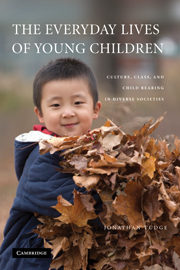Book contents
- Frontmatter
- Contents
- Preface
- Acknowledgments
- 1 Introduction and Stage Setting
- 2 The Daily Lives of Toddlers
- 3 Cultural–Ecological Theory and Its Implications for Research
- 4 Methods
- 5 Life in the Cities
- 6 Everyday Activities
- 7 Settings and Partners
- 8 Everyday Lives
- 9 The Cultural Ecology of Young Children
- References
- Index
- Frontmatter
- Contents
- Preface
- Acknowledgments
- 1 Introduction and Stage Setting
- 2 The Daily Lives of Toddlers
- 3 Cultural–Ecological Theory and Its Implications for Research
- 4 Methods
- 5 Life in the Cities
- 6 Everyday Activities
- 7 Settings and Partners
- 8 Everyday Lives
- 9 The Cultural Ecology of Young Children
- References
- Index
Summary
One is constantly wondering what sort of lives other people lead, and how they take things.
George Eliot, Middlemarch, 1872/1988, p. 268To this point, I have concentrated on the various types of activities in which the children were involved, how the children became involved in those activities, where they were situated, and the extent to which their differing settings changed the extent to which they were involved in various activities, and their main partners in their activities. However, this approach has not allowed us to see the ebb and flow of children's lives, to view children's everyday lives in a more holistic way. In this chapter, therefore, I focus on the children themselves, drawing on the field notes that the observers wrote as they did the live observations. I've chosen four periods during the day: in the morning; early afternoon; late afternoon/early evening; and the time leading up to the children going to sleep.
It's important to specify that I haven't chosen children to illustrate any particular points. There were only two criteria for choosing specific children. The first was that I should draw equally on children from each city (the only exception being in Greensboro, where we collected data from two ethnic/racial groups), with equal numbers of children from middle-class and working-class families. The second was that, having decided to illustrate these four times of the day, the observations had to cover a minimum of two hours.
- Type
- Chapter
- Information
- The Everyday Lives of Young ChildrenCulture, Class, and Child Rearing in Diverse Societies, pp. 221 - 258Publisher: Cambridge University PressPrint publication year: 2008

